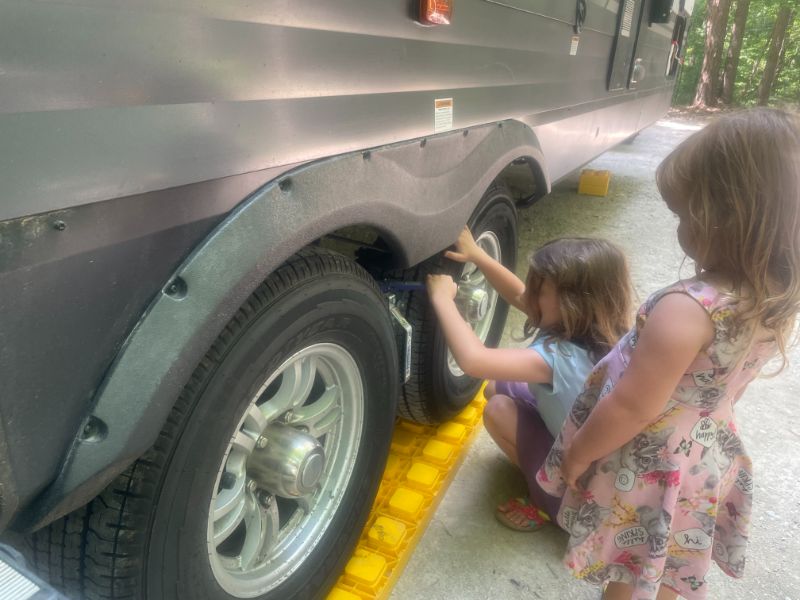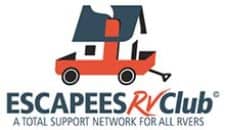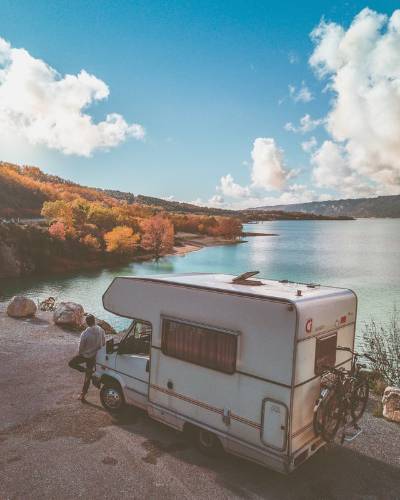When you first started considering the digital nomad life, your inner adventurer (who is likely still childless, working a great job, and has a whole lot of disposable income) probably started firing ideas off with all of the possibilities of sublime fun to be had. Then the parent-guardian voice kicked in and said, “Um, are you forgetting something?”
So today you asked yourself: Can you be a digital nomad with kids?
Yes. Is it going to take some extra planning and effort? Yes.
But, you and thousands of other families are thinking about taking a leap that many have already taken. In fact, according to the New York Post, over 400,000 American families had traded in their white-picket fences for a pair of wheels and a nomadic lifestyle in 2020.
I know it’s hard to keep track of time lately, but it’s 2022. So, get a move on.
Here are some tips on how.
OPTIONS FOR REMOTE WORK

One of the greatest advantages we have over our parents’ generation is that we have the ability to work remotely. And, despite what their Instagram pages might convey, digital nomads still need to work, especially if they have a family to support.
You’d be surprised how quickly you can build a digital career if you are motivated to do it.
A year after I started writing blog content, I had regular clients, multiple works published under my own name, and had developed a good understanding for SEO and how to monetize a blog!
Here are a few of the many ways you can become your own digital boss:
- Offer freelance services
- Start a blog
- Teach or tutor English
- Become a virtual assistant
- Do social media management
It will take anywhere from 3-24 months to develop a client base and establish your personal brand, but you can easily begin these jobs as a side hustle and begin making at least $30,000-$40,000 within a year!
You also might be interested in 7 tested strategies for making money on the road!
If working for yourself isn’t your thing, many companies have come to see the benefits of allowing employees to work remotely. Many jobs in IT, administration, data analysis, and technical design can be performed remotely.
Pro tip – I learned the hard way so take it from me; if you rely on a strong internet connection, you need to factor that into your planning!
TAKING ON “ROADSCHOOLING”
As digital nomads, you will need to take on the responsibility of ensuring your kids are keeping up with their education. Thankfully, it’s a lot easier to do so these days with the multitude of online resources and virtual access. To get started, here’s what you need to think about:
- Do your research. There are different ways to go about homeschooling, and you can customize your program according to the needs of your family. You can take advantage of free or low-cost online educational tools like Kahn Academy and MIT OpenCourseware.
- Learn about the requirements for homeschooling in your state. You need to ensure your children’s education will be recognized when you return home. For assistance, contact the Homeschooling Legal Defense Association (HSLDA).
- Decide on the curriculum. You can often incorporate similar concepts as you’d find in Montesorri or forest school alongside the standard curriculum. There are many homeschooling curricula options, such as The Great Courses and Abeka.
- Define your goals. Determine what your kids need to get out of the term, but also what you want them to get out of it.
- Set a schedule, and stick to it. Make your schedule according to whatever works best for your family. For some, that means mornings Friday through Monday, for others, it might look more like the traditional timetable.
Most importantly, don’t go it alone!
As digital nomads, your homeschooling space is likely to change. Even if you’re living in an RV or a skoolie – a converted school bus – the surrounding environment will be filled with different sensory experiences. Think of how you can create a space for your children to focus on their school work.
Here’s a guide to childproofing your mobile living space!
You’re also going to be leaving your community behind, so it can also be really helpful to join an online homeschooling group so that you can share and receive tips, advice, and stories. Many homeschooling groups have a local social media chapter.
FINDING FRIENDS

Part of the decision to live your lives as digital nomads is the choice to break from the barriers of tradition. But, you still need to think of your child’s development within the scope of normal, healthy requirements and that includes their social time.
There are different ways you can foster social experiences for them as a nomadic family:
- Plan ahead and stay at family-friendly locations
- Sign them up for activities at your destination
- Schedule regular facetime calls with friends and family from back home
- Have them send messages, emails, and snail mail to friends at home and that they’ve made along the way (pen pals are so underrated!)
- Set up play dates with other nomadic families
- Plan to meet up again with friends you’ve made on the road
If you’ll be traveling in an RV, there are clubs, meetups, rallies and organizations everywhere! Wayfinding Wheels broke down the “loneliness myth” at Breaking 11 Myths about Full-Time RV Travel.
If you plan to travel full-time with your family, check out organizations like the Family Motor Coach Association (FMCA) and Xscapers.
TRAVELING SLOOOOOOOOW

Being a digital nomad isn’t going to be exactly like when you backpacked out of college. Moving from city to city in a matter of a couple of days isn’t realistic as kids need routine and consistency. It’s just simply more difficult to travel with them because there are more moving parts. However, many have begun embracing slow travel.
It’s a concept that began out of criticism (and perhaps bore) of the bucket list trend that encouraged travelers to get as many checks on the destination list as possible, without really considering what that meant for:
- The communities they stopped in;
- The well-being of the environment;
- Their own ability to experience the place, culture, and society.
It’s how I choose to travel, and I’m not saying that to seem as though I’m ahead of the curve; it’s something I learned from my parents. Slow travel means staying in one place longer and not rushing to see the most popular sites, but rather finding a different means and pace of exploration, taking the less beaten hiking trails, and eating in the restaurants outside of the tourist area.
Lori and Angelo at the blog Travlinmad break down what it means to slow travel.
Slow travel is all about experiencing the true essence of the place, but also giving it the respect and honor it deserves.
A good navigation app can help you thoroughly explore and appreciate a destination rather than just rushing through the top 3 listings on Trip advisor. Here’s a list of must-have camping and travel apps for nomadic families.
FINDING ENTERTAINMENT
I have vivid childhood memories of my dad strategically jamming the entire crew into the family minivan, making sure nothing important was left behind. How many times do you think their four children under the age of ten asked, “Are we there yet?” as we made the 20+ hour drive from Southern Ontario to the lower Eastern states each year? This was before portable DVD players, let alone iPads. You remember the days.
Thankfully my parents always planned ahead and found ways to keep us entertained. Here are some ideas on how to provide entertainment for the journey:
- Bring games, cards, reading and activity books
- Bring the iPads; make sure they’re charged and download content beforehand
- Plan out stops along the way for physical and mental stretches
- Stop to do a bit of sightseeing
- Pack healthy snacks
Remember that keeping your kids entertained is more than just surviving the journey, and making sure the iPads are packed – it’s about their wellbeing. They have as much a right to find joy and fulfillment in this journey as you do. And, travel can easily take its toll on them just as it does on us.
Finding free and affordable adventures isn’t too hard. Your kids may not have the experience of joining a soccer league, but they could ride their BMX bikes in all 50 states!
TRAVELING WITH A FAMILY – FAQ

What Is a Digital Nomad Family?
A digital nomad family is one in which one or more parents/guardians work digitally and remotely while traveling with their kids, and pets, in tow.
That’s the formal definition that describes how a family can pick up and leave a more stationary lifestyle. However, I think it kind of downplays the adventure, the bonding experiences, and the fulfillment you can find as a digitally nomadic ‘household’. Nothing like having to ‘hold it’ when your son (brother, in my case) has plugged the toilet yet again. Family bonding.
Living on the road is not always easy. But it’s worth it!
Is It Lonely Being a Nomad?
It can be! Especially for extroverts, but we all need human connection. Even though you’re family is with you, when you’re on the road for long periods of time it’s easy to miss friends and family who are back home. The ‘silence’ can be deafening when you’re experiencing something incredible and you want to share it with another adult, even when your spouse is right beside you.
It’s the familiarity of your family that allows you to travel together for extended periods, but that’s also the thing that can make you crave social connection.
You can take it as an opportunity to meet the locals, especially when you stay away from the tourist traps. I was a server for a long time and my nomadic spirit always loved chatting with travelers visiting my city (I’ll also take this as an opportunity to point out that you need to learn local etiquette including tipping!)
Can I Become a Digital Nomad with Pets?

Yes, you can!
But be aware that traveling with kids AND pets can be cumbersome, to say the least. You won’t be living the fairy tale city-hopping nomadic life you see on Instagram.
RVing and traveling with pets is a challenge, but it can do be done! You’ll need to pet-proof your space, update all vaccinations, get an ID chip, and plan well ahead. Lots of camping locations or tourist destinations don’t allow pets, so you’ll have to be willing to sacrifice for your furry friends.
How Much Money Do You Need to Become a Digital Nomad?
This is a question that I’m always wary of answering. I was recently discussing this with my sister, who’s been a nomad her entire adult life. We’ve both found that it’s difficult to get an accurate picture until you get to your destination, and things almost always cost more than you’d expected.
Not only do exchange rates change all of the time, but the cost of goods and services change frequently. Not to mention the fact that lifestyle factors into it, plus individual needs like medication and therapy (sidenote: if you’re in South East Asia, I doubt your stateside therapist is staying up to take your call).
For instance, if you’re planning on living in an RV, we’ve broken down some of the common RV living expenses here.
That doesn’t mean you can’t or shouldn’t budget ahead – you absolutely should – but consider starting off somewhere that is well within your means. I personally try to find resources developed by people living in the area of my destination.
I also join ex-pat Facebook groups and follow travelers on Youtube who are currently on location. I also love blogs (of course) but warn you to beware of the dates on the blog posts that give you quantifiable data.
Especially when traveling abroad, I really encourage you to be aware of how your privilege provides you the ability to live this lifestyle and to be actively conscious of your impact on the spaces and communities you visit.
I want to congratulate you on taking this step toward becoming a digital nomad with kids!
It can seem like an overwhelming thought but I, and thousands of other families, promise you it is doable.
Take your time, have fun planning and get the kids involved, and do the damn thing!
If the thing that I will not name has taught us anything, it’s that tomorrow isn’t promised, and if it does come we’d rather experience challenge and adventure than be stuck in a job we hate, living a life that someone else wrote for us.
Lauren Schmalz lives in Toronto, Canada. Her love of travel began as a child when her parents would bring the family south of the border to explore the Eastern States. She’s traveled across North America, Europe, Asia, and Northern Africa. She is an advocate of slow travel and the road less traveled. She can be found enjoying the city with her Thai rescue dog or enjoying a good meal and glass of wine with friends and family.
-
Lauren Schmalzhttps://changingears.com/author/lauren-schmalz/
-
Lauren Schmalzhttps://changingears.com/author/lauren-schmalz/









